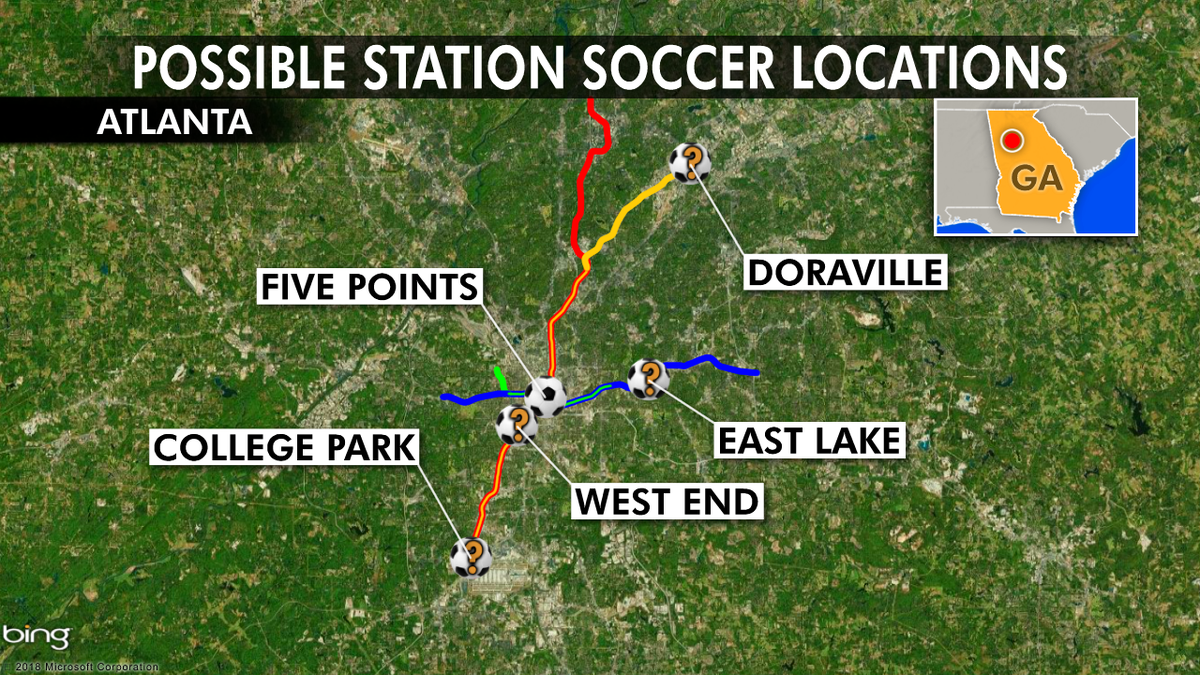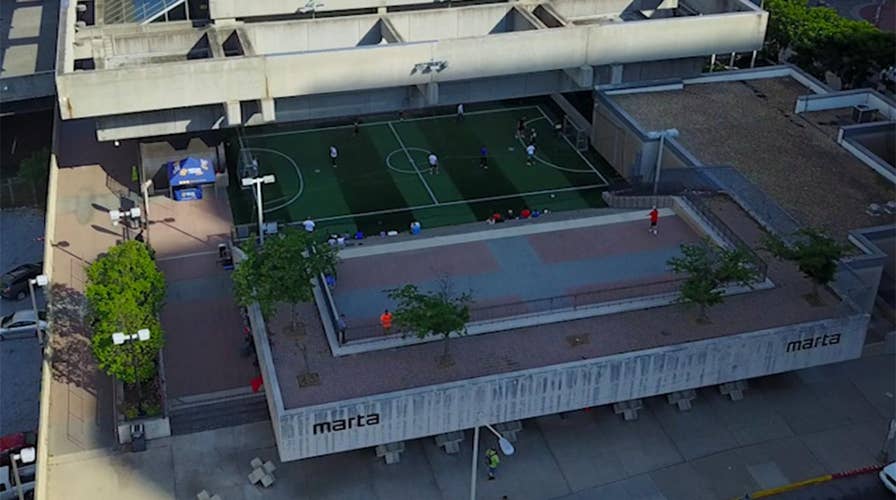Subway soccer fields multiply in Georgia
On top of Atlanta's busiest subway station sits a five-a-side soccer pitch with the goal of exposing the sport to underserved communities.
ATLANTA – From the street, this city's Five Points MARTA station seems like any other subway stop – with the usual city smells, rumbling rail cars and weathered sidewalks.
But it’s actually extraordinary – on the international level. A view from above explains why.

A Fox News drone pilot captures an aerial view of the Five Points MARTA Station in Downtown Atlanta. (Fox News)
A five-a-side soccer field sits on top of the city’s busiest subway station, transforming an unfinished community space that had been roped off for years.
“Why not eliminate that [vacant space] and build fields at stations?” Sanjay Patel asked himself, after seeing kids use the subway in the United Kingdom to get to games. “[We can] use the existing transit network to connect communities.”
When he began proposing his idea to others, Patel said “a lot of people thought it was kind of an outlandish, crazy idea that probably wouldn’t come to fruition.” After all, this would be the first subway station in the world with a soccer field on top of it.
But he had one big believer in his so-called crazy idea – Phil Hill, the executive director of Soccer in the Streets, an Atlanta-based youth athletic program.
Hill runs the non-profit organization, shuttling underprivileged kids to soccer games around the city – a field of work inspired by his world travels.
“I could put a soccer ball down in the middle of a desert in Egypt or a harbor side in Turkey and start playing soccer with locals or kids,” Hill recalled. “It was an instant connection.”
But when he arrived in Atlanta in 1993, he quickly learned the city operated differently. Hill said private fields – reachable only by car – along with steep participation fees sharply limited access to the sport.
In 2016, Soccer in the Streets introduced its first subway station field, dubbed Station Soccer.
David Sumpter is a professor in Sweden and analyzes the intersection of math and soccer around the world. He applauded Atlanta’s project, calling it a great use of urban space. “Football should be the most accessible of sports because it’s so easy to play,” Sumpter told Fox News in an email.
He cited a similar five-a-side pitch under a motorway in Manchester, England. “The less space the players have, the better they get technically,” Sumpter said.

Station Soccer players wave at their friend, who is wearing a GoPro on his head, at their Sunday afternoon practice. (Fox News)
People of all ages can take MARTA to the field for events, leagues and pick-up games, which are free for kids.
Rinah Gardner said as a mother of three, the free programming has been a blessing for her family.
Another parent, Luis Nieves, agreed. “It’s why I come here,” Nieves said. “Because we don’t have a lot of money, so I come here because it’s a good opportunity for [my son, Yamil],” who dreams of going pro.
Collaboration between Soccer in the Streets, the Atlanta United Foundation, MARTA and several local lighting and turf companies funded the $150,000 project.
The non-profit plans on opening nine more fields at MARTA stations throughout the city, one as early as this summer.
“We can connect the Hispanic kids in the North, African American kids in the West, refugee kids in the East” all through MARTA, Hill said, transforming Station Soccer into the League of Stations.

Soccer in the Streets is currently evaluating Doraville, East Lake, West End and College Park as potential Station Soccer locations. (Fox News)
Jose Navarrete, 11, took MARTA with his older sister to a Sunday afternoon practice. This is exactly the type of convenience Patel dreams of bringing families with the League of Stations.
“I‘ll die happy the day I see kids on the train here in Atlanta with soccer gear on going to play other kids,” he told Fox News.
But the players aren’t the only ones benefitting from Station Soccer.
Now, more than a year since the field’s implementation, MARTA police found their primary concern around safety at the station actually improved as a result of the program.
Amanda Rhein, senior director of transit oriented development, said by putting more people around Five Points, Station Soccer has “deterred more negative activity.”
As additional fields are rolled out across the city, she is hopeful that same improvement in safety will be mirrored at other stations.
MARTA has not seen a change in ridership numbers since the field’s implementation, but Rhein is confident the development of the League of Stations will make Atlanta’s notoriously underutilized public transportation more popular.
Rhein said the fields are not permanent, but instead more of a stepping stone to another, larger development project. Although, that’s not to say the fields will all disappear after five years. She added the transit agency could rotate the fields to different stations.
As with many “firsts,” Station Soccer has attracted attention from around the country. Rhein cited dozens of inquiries from transit agencies, municipalities and public and private planners regarding the field at Five Points.
The concept opens up the sport to people who never considered soccer feasible for their kids because of cost and transportation issues. And by expanding the pool of players, Station Soccer said it is improving talent in the city.
“So that’s an exciting part, just as a soccer fan,” Hill said, “that we can be instrumental in creating a model” that can maybe one day help America win the World Cup.
But for Hill, improving America’s level of play is just a nice byproduct of the program. The non-profit’s priority is improving the quality of life for kids and “opening their eyes to what’s possible in the world.”

